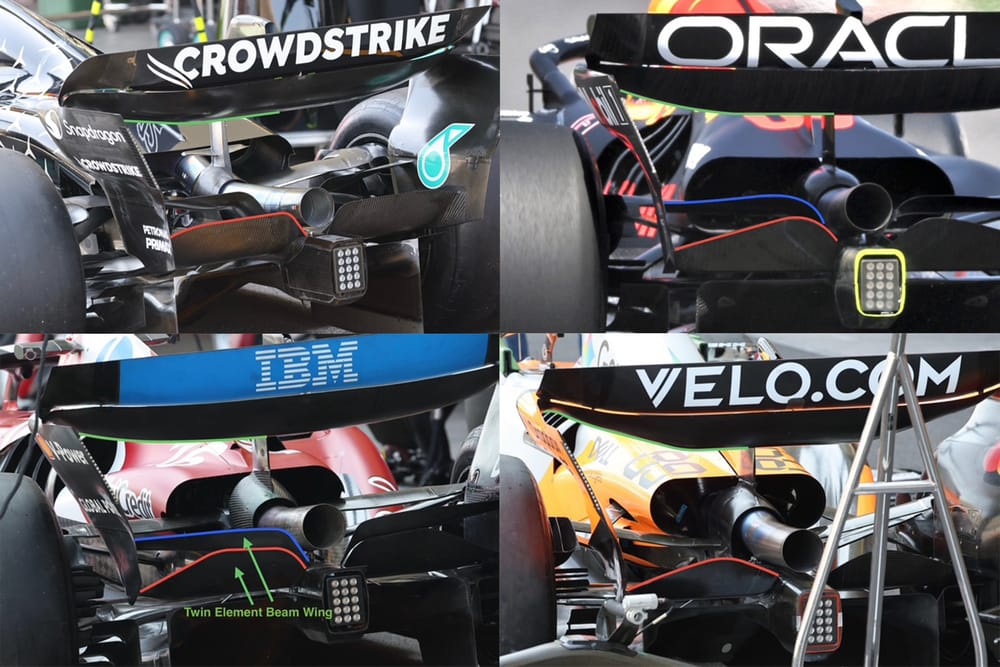Formula 1's Mexican Grand Prix has its own unique set-up requirements thanks to Mexico City's altitude of 2240m above sea level, meaning the air density is reduced by roughly 25%.
Lower air density, and therefore less oxygen, means that everything suffers - although, as ever, some cars suffer more than others. And that's why it's the ideal venue to take a look at the rear wing designs of McLaren, Red Bull, Ferrari and Mercedes.
If I were to rank the rear wing levels across the top four teams from maximum to minimum downforce, it would go: Mercedes; Red Bull; Ferrari; and then McLaren. So that's the order to look at them in.
Mercedes has a brutal beam wing that effectively continues across the width of the trailing edge of the diffuser (highlighted in red). It also uses most of the allowable upper wing cross-section (green highlight).
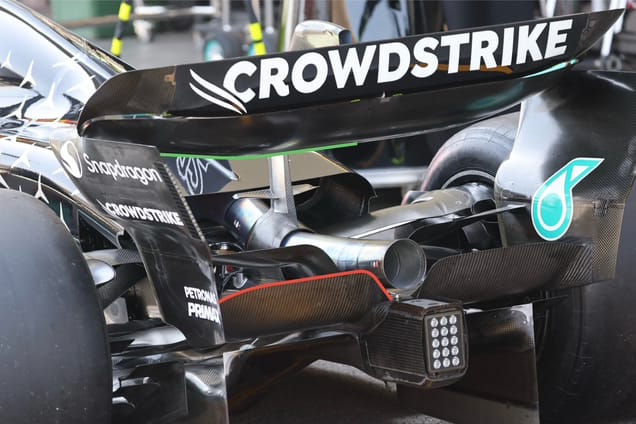
This detail at the end of the rear flap and how it runs into the endplates (highlighted with the red ellipse) will also generate more downforce than the more common slot gap separation that we see on most other cars in this area.
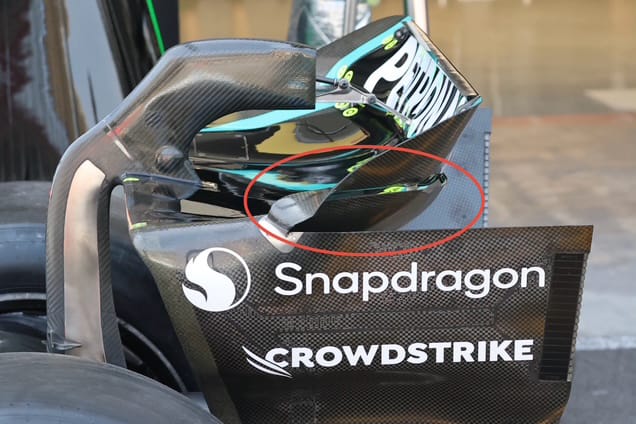
Red Bull is a little bit different in that it has gone for a twin-element beam wing. The lower element trailing edge is highlighted with a red line and the upper element trailing edge highlighted with the blue line.
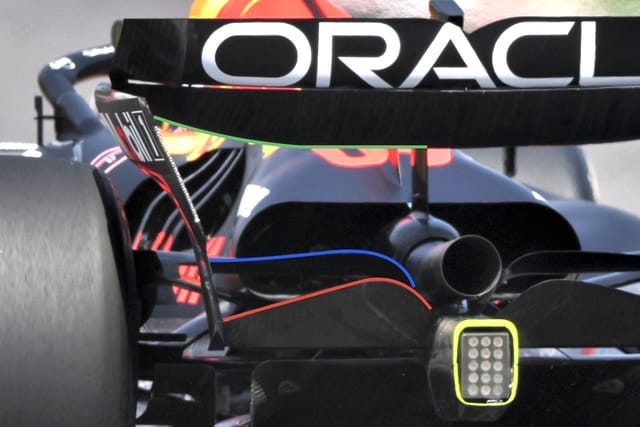
The maximum chord section is inboard, and is therefore scavenging the inner section of the diffuser to its maximum. This is the area of the diffuser that needs the most help to reduce the risk of airflow separation.
The upper wing is using most of its allowable cross-section, which is highlighted with the green line.
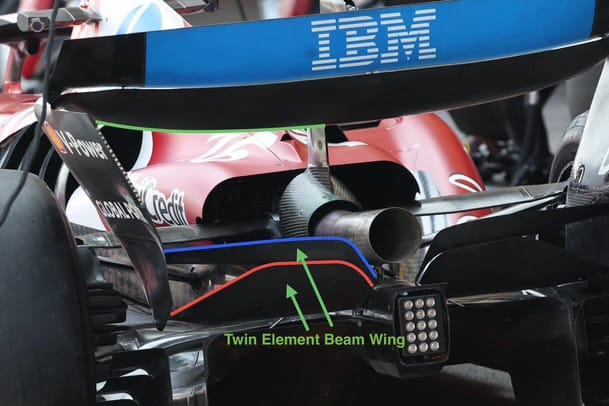
Ferrari is also using a two-element beam wing. As with the Red Bull version, I have highlighted the trailing edge of the lower element with a red line and the trailing edge of the upper element with a blue line.
As is the case for Red Bull, this will be a little more efficient, but it doesn't work the diffuser quite as dramatically. Also, Ferrari is not using quite as much of the upper wing's cross section (green highlight) as Mercedes.
Constructors' champion McLaren has what is, in my opinion, the lowest rear wing downforce level of the top four. The green highlight line shows how the lower surface sweeps upwards much earlier than the others as it goes outboard.
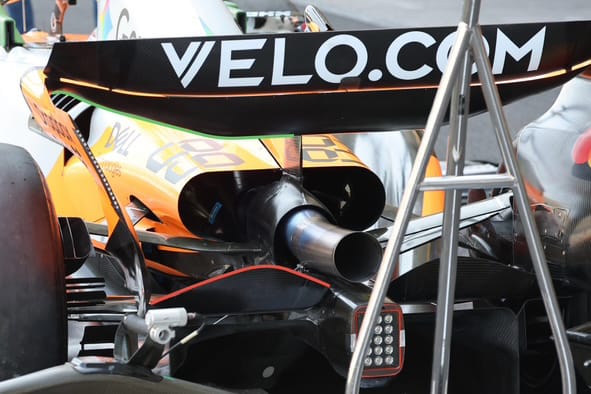
Also, its beam wing is not as dramatic as the Mercedes. As you can see from the red highlight, it doesn't interact with the diffuser for very much of its span.
Who is right? We will see who adds or takes away downforce as the weekend progresses. But downforce and drag unfortunately go together, more of one means you get more of the other and on Saturday you will want maximum grip, on Sunday you will want straightline speed. As ever, it's a compromise. And the set-up challenge is not straightforward.
If you take it as a given that the overall downforce and drag will be reduced by 25%, this means that teams will run with high-downforce wings such as those used in Hungary. However, the air density has wider implications than simply reducing downforce.
At a normal track, Austin for example, the static ride height in the pits would be around 25mm front and 60mm rear. At top speed, when the downforce is at its maximum, that would lower to around 5mm front and rear as the downforce builds. Yes, the car hits the ground and we see the sparks, but that's just caused by the bumps; it doesn't sit on the ground constantly.
For Mexico, that all changes - but not by the 25%. If you take the maximum speed difference from roughly 320km/h (199mph) at a 'normal' track to 360km/h (224mph) in Mexico and then take into account the fact that the downforce increases at the square of the speed, that maximum downforce at top speed will be reduced by roughly 10%. This means that for the same static ride heights at top speed, the ride heights would be roughly 7mm front and 9mm at the rear.
To react to this, you could either run the car softer or reduce the static ride height to compensate. Running softer will improve the car's ride over the kerbs, while lowering it will help increase the downforce as the speed builds up, so through the slow- and medium-speed corners. If you take a comparison corner at something like 250km/h (155mph), then you will lose that 25% of downforce, so cornering grip is reduced by that same 25%.
The main problem is actually cooling the brakes. As the speed is faster at the end of the main straight and the car weight is the same as normal, the brakes need to work harder so high temperatures can be a problem. Also, add in that 10% less downforce and you need to use the brakes for longer than normal.
If they get to anywhere near 1000°C, then the wear rate increases exponentially. Also, if you cool them too much, say to less than 350°C, then they are less effective when you initially apply the brakes and on other, less-intense braking sections of the circuit. If you see clouds of black dust coming out of the wheel or front brake cooling ducts you are in trouble. In the race, everyone will be doing a bit of lift and coast to get some speed reduction in before hitting the brakes.
As for the power unit, with the turbo you lose less power than you would with a normally aspirated engine. The turbo makes up for some of that air density loss. You still lose some power: probably in the region of 10%, mainly because the turbo just can't work any harder. It is limited to 125,000rpm and most teams will get close to that at normal circuits, so there's not a lot of headroom left. But that also means you need less fuel for the same combustion: less oxygen requires less fuel.
Mexico is where in the past we have seen the Ferrari - and mainly the Ferrari engine - being very competitive. One of the reasons is that it has a different turbo specification than others. From what I know, it is smaller so speeds up faster, meaning that it can recover some of that loss in induction pressure better through the acceleration phase.
Yes, those Ferrari-engined cars lose out a little at the top end when you can't run the turbo above the 125,000rpm limit, but overall with the reduced air density they seem to have a reasonable compromise. That could be good news for Ferrari power unit users. If Charles Leclerc and Lewis Hamilton, or any of the others, get into potential podium positions, it could play havoc with the outcome of the drivers' championship.
However, with the air density reduced by 25% and the power reduced by 10% it means that you need more engine cooling and engine ancillary cooling, so we will see those engine cover cooling exits opened up.
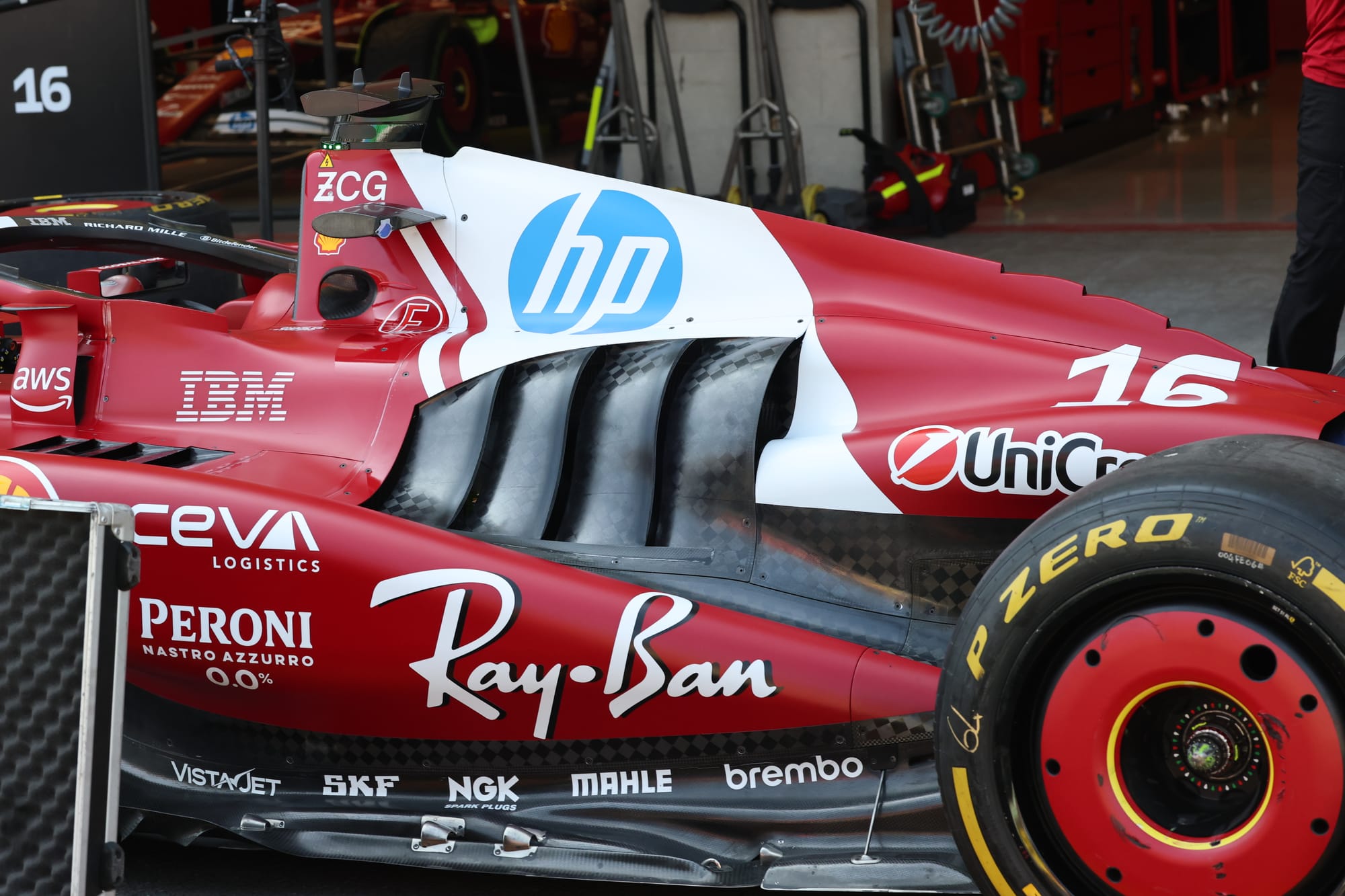
In the old days, some of the engine companies would build special normally aspirated engines for Mexico with higher-compression ratios to compensate for the loss in density. For 1992, Yamaha did just that. It wouldn't even let us at Jordan start the engines up before we got to Mexico, but performance-wise they were just that little bit better relative to others - albeit still very unreliable.
Post-Mexico, we went testing at Pembrey in Wales, just about as close to sea level as you can get. We lost our first normal-compression-ratio engine almost immediately and all we had for a spare was a high-compression-ratio engine from Mexico.
Yamaha didn't want to use it but I insisted we needed to test. We fitted it and it ran faultlessly with reasonable performance for a day and a half. I asked Yamaha to build future engines to this specification but it wouldn't because it said we wouldn't be able to use them at normal altitude. Strange.
So, how will the rest of the weekend play out? I don't expect to see much difference to who is in the leading bunch, but there might just be a little bit of a mix up between them and that means it could close up the championship points or spread it out again. We won't know until Sunday night, but it's going to be fun on the way.


